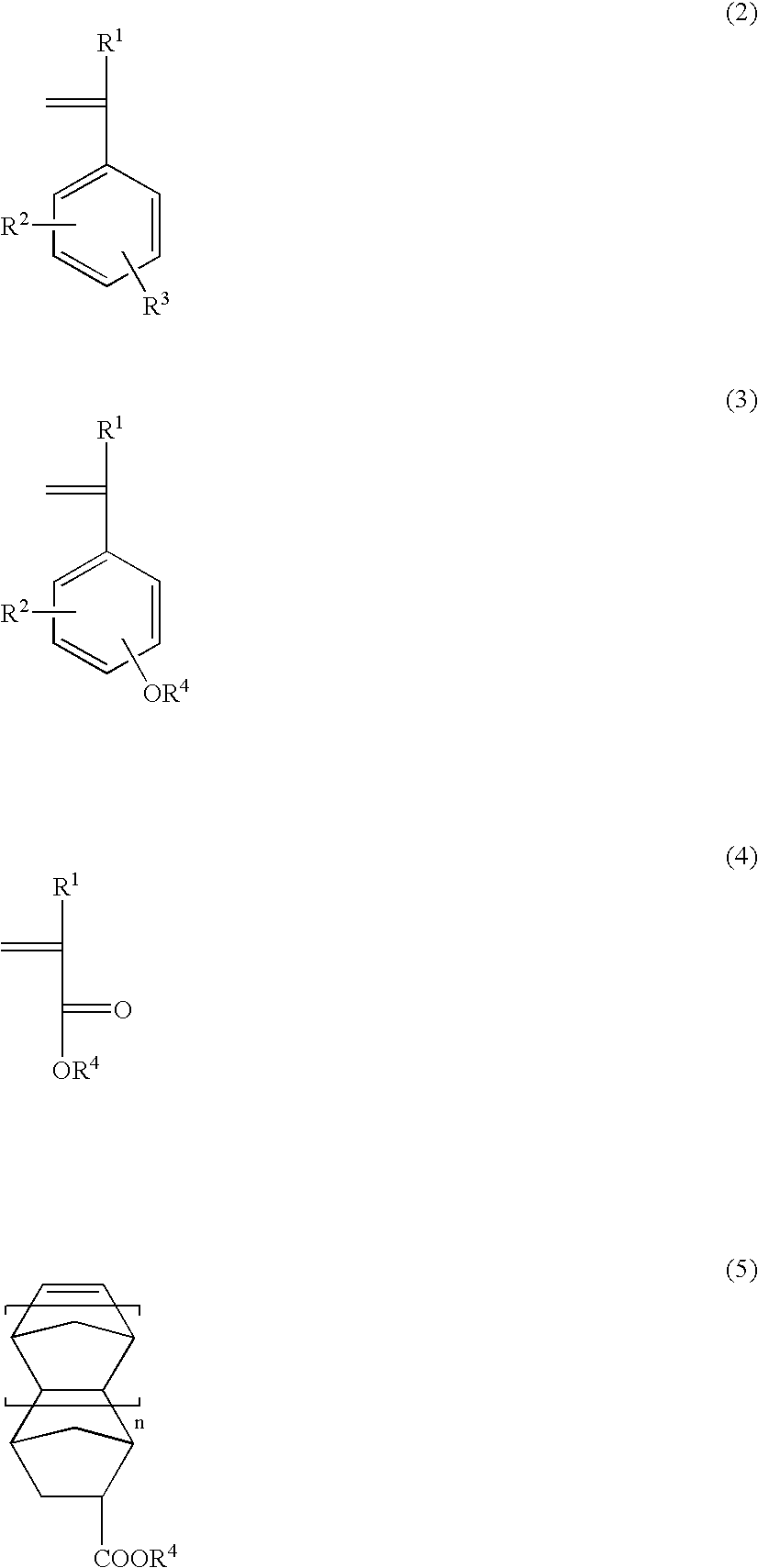Hyperbranched polymer, production method therefor and resist composition containing hyperbranched polymer
a production method and polymer technology, applied in the field of hyperbranched polymer, can solve the problems of poor adhesion of polymer to substrate, polymer has not succeeded in patterning 50 nm or narrower, and the side wall roughness of formed patterns is an issue, etc., to achieve excellent etching resistance and film-forming properties, improve surface smoothness and alkali solubility, and improve the effect of sensitivity
- Summary
- Abstract
- Description
- Claims
- Application Information
AI Technical Summary
Benefits of technology
Problems solved by technology
Method used
Image
Examples
example 1a
Synthesis of Hyperbranched Polymer
[0167] In a 50 mLreaction vessel, 21 mmol of chloromethyl styrene as a reactive monomer, and 2.1 mmol of 2,2-bipyridyl and 1.1 mmol of copper (I) chloride as a catalyst were placed together with 8 mL of chlorobenzene as a solvent. After the atmosphere in the reaction vessel was replaced with argon, a polymerization reaction was carried out with stirring at 115° C. for one hour. With the addition of 50 mL of tetrahydrofuran to the obtained reaction liquid, the resultant polymer was diluted and dissolved. After that, the reaction mixture was filtered through activated alumina to remove the catalyst. After the obtained filtrate was concentrated, the polymer was precipitated by the addition of 200 mL of methanol and the supernatant fluid was eliminated, thereby removing the unreacted monomers and the reaction solvent. Subsequently, the precipitated polymer was dissolved in 20 mL of tetrahydrofuran, and thereafter reprecipitated two times with the addi...
example 2a
Synthesis of Hyperbranched Polymer
[0174] The same procedure as in Example 1 was repeated to carry out the polymerization except that the amount of catalyst was increased by five times, the reaction temperature was changed to 125° C., and the reaction time was changed to 30 minutes in the step of synthesizing the hyperbranched polymer, so that a polymer 2 was synthesized (in a 77% yield). The weight f branching (Br) of the obtained polymer 2 were measured in the same manner as in Example 1. The results are shown in Table 1A.
[0175] The same procedure as in Example 1 was repeated except that 1 g of the polymer 2 was used as the starting polymer, the amount of p-tert-butoxy styrene as an acid decomposition group-containing compound was changed to 65 mmol, and the reaction time was changed to 3 hours to carry out the polymerization with p-tert-butoxy styrene and the subsequent purification in the step of introducing the acid decomposition group. Thus, a desired acid decomposition grou...
example 3a
Synthesis of Hyperbranched Polymer
[0177] The same procedure as in Example 1 was repeated except that the amount of catalyst was increased by four times, the reaction temperature was changed to 125° C., and the reaction time was set to one hour in the step of synthesizing the hyperbranched polymer, so that a polymer 3 was synthesized (in a 78% yield).
[0178] The weight average molecular weight (Mw) and the degree of branching (Br) of the obtained polymer 3 were measured in the same manner as in Example 1. The results are shown in Table 1A.
[0179] The same procedure as in Example 1 was repeated except that 1□ of the polymer 3 was used as the starting polymer, 65 mmol of p-ethoxy ethoxy styrene was used as an acid decomposition group-containing compound, and the reaction time was changed to 3 hours to carry out the polymerization with p-ethoxy ethoxy styrene and the subsequent purification in the step of introducing the acid decomposition group. Thus, a desired acid decomposition gro...
PUM
| Property | Measurement | Unit |
|---|---|---|
| wavelength | aaaaa | aaaaa |
| wavelength | aaaaa | aaaaa |
| wavelength | aaaaa | aaaaa |
Abstract
Description
Claims
Application Information
 Login to View More
Login to View More - R&D
- Intellectual Property
- Life Sciences
- Materials
- Tech Scout
- Unparalleled Data Quality
- Higher Quality Content
- 60% Fewer Hallucinations
Browse by: Latest US Patents, China's latest patents, Technical Efficacy Thesaurus, Application Domain, Technology Topic, Popular Technical Reports.
© 2025 PatSnap. All rights reserved.Legal|Privacy policy|Modern Slavery Act Transparency Statement|Sitemap|About US| Contact US: help@patsnap.com



